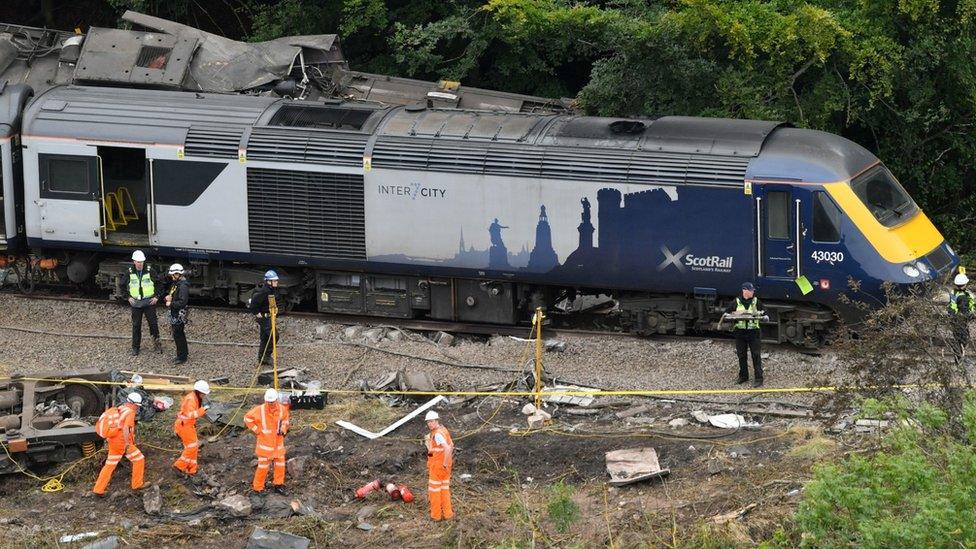Has Network Rail got off lightly over train crash?
- Published

The derailment happened near Stonehaven on 12 August last year
It's three years since the Aberdeen to Glasgow train ploughed off the line near Stonehaven.
Three people died after the train hit a landslide at Carmont and derailed.
The toll could have been much higher, if the train had not been almost empty that day.
Since then, a long investigation has tried to answer three key questions: what went wrong, who's to blame, and what can be done to prevent a similar tragedy in future?
Among the specific findings, highlighted in court was the fact that a drainage system in the area was incorrectly installed by the giant construction firm Carillion, which has since gone into liquidation.
Network Rail engineers had not fully inspected this drainage system. So problems were spotted too late.
Driver Brett McCullough, 45, conductor Donald Dinnie, 58, and passenger Christopher Stuchbury, 62, died in the crash.
The judge, Lord Matthews, said no penalty he could impose could compensate for the loss suffered by the families of those who died and of the six people on board the train who were injured.
Network Rail has now been fined £6.7m after pleading guilty to a number of maintenance and inspection failures before the crash in August 2020 and failing to warn the driver that part of the track was unsafe or tell him to reduce his speed.

Donald Dinnie, Christopher Stuchbury and Brett McCullough died in the crash
But officials at the RMT rail union are angry.
They say Network Rail has got off lightly - and that corporate manslaughter charges must be made an option in similar cases in future.
Network Rail is in charge of rail infrastructure across the UK, so it's having to make sweeping changes in response to this crash.
Twenty key changes are recommended. So far, just two have been completed by Network Rail.
Several more, they say, await approval by rail regulators. The rest, they claim will be in place in the next two years, or will fall to rail operators to implement.
Rail unions are frustrated at this pace of change. Without rapid progress, they warn, the lives of passengers and rail workers remain at risk.
Officials at Network Rail say they're working fast to introduce complex changes, many of them UK-wide.
Climate change
This crash shows how extreme weather can wreak havoc with the rail network.
Torrential rain and flooding damaged the rail line at Stonehaven in the hours before the derailment.
Network rail point to lessons learned: more investment in front-line inspection teams, and remote monitoring systems to bring early alerts from danger areas.
More helicopter inspections, they say, are planned in remote areas, with river levels monitored better to highlight potential flooding.
All this costs a fortune.
Network Rail say that in 2014-2024, they've committed around £200m on drainage systems, earthworks and bridge protection in Scotland alone.

The train hit debris in heavy rain
More severe storms mean falling trees cause more regular damage to overhead electric rail lines. This, in turn, brings services to a halt. So a ramped-up programme of tree-felling is in place around the network.
And extreme weather demands better planning. In the Network Rail control centre in Glasgow, a specialist weather team is now in place - the first of its kind in the UK.
These meteorologists are tasked with providing 24 hours a day over-watch, so route control managers can respond better to extreme local conditions.
This aims to help them decide when to slow trains down or close lines altogether, when the weather's particularly bad.
Will this be enough to avert a similar tragedy in future?
With so much of Scotland's rail network running through remote and mountainous Highland terrain, it's clear that climate change and extreme weather present real danger - whatever's done to blunt its impact.
- Published8 September 2023

- Published7 September 2023

- Published7 September 2023
